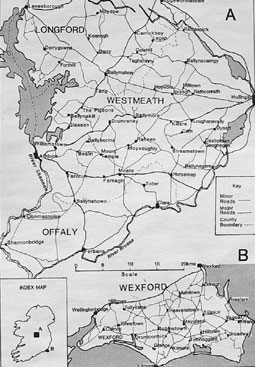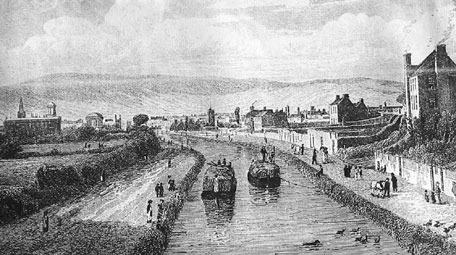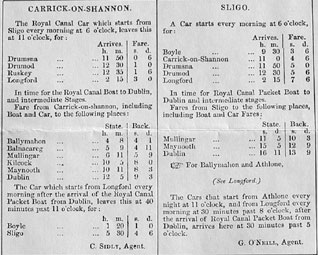
|
Home > The Journey: Irish Road to South America The Irish Road to South America |
|||||||
By
Edmundo Murray |
|||||||
|
|||||||
| In order to answer these questions we need to recall some facts of the Irish emigration to Argentina. During the nineteenth century, forty to forty-five thousand emigrants left Ireland to settle in Argentina and Uruguay [1]. Approximately 20,000 re-emigrated to the United States, Australia, Ireland or other areas, and 20,000 settled in the country. A majority of the emigrants bound to Argentina came from the Irish Midlands (Westmeath, Longford and Offaly) and from Co. Wexford. According to Peadar Kirby, they ‘came from two clearly defined areas, south-east of a line from Wexford Town to Kilmore Quay in Wexford, and from a quadrangle on the Longford/Westmeath border stretching roughly from Athlone to Edgeworthstown, to Mullingar and to Kilbeggan. Virtually the whole population surrounding the town of Ballymore, which stands roughly at the centre of this quadrangle, emigrated to Buenos Aires in the 1860s’ (Kirby 1992: 105) [2]. As early as 1842, during his ride through the Buenos Aires province, William McCann estimated that ‘at least three-fours of the [Irish] emigrants are from the County Westmeath’ [McCann 1853: 195]. In his study of the Irish migration to Argentina, Patrick McKenna argues that ‘the numbers from Westmeath and south Longford were to make up about two-thirds of the total number of Irish emigrants to Argentina’ [McKenna 1992: 69]. The same author, based on Coghlan 1987, estimated that 43.35% emigrants were from Westmeath, 14.57% from Longford and 15.51% from Wexford [81]. These were the typical origins of the emigrants who established themselves in Argentina until September 1889, when poor urban families and labourers from Dublin, Cork and Limerick were induced by Argentine government agents to emigrate to Buenos Aires in the steamer City of Dresden. I will firstly analyse the inland transportation patterns of Midlands and Wexford emigrants, then the journey to Liverpool and the stay at this port, followed by the journey to the River Plate Emigrating from the Midlands
Many factors contributed to create the reputation of Argentina as a region were land acquisition was easier than other places, particularly, letters and news from early emigrants, newspapers articles in English published in the British Isles and in Argentina, and travel handbooks. Additionally, since Argentina was not part of the formal British Empire (though connected to England by strong trade and social links up to the 1930s), most legal burdens at home would not annoy the emigrants in their adopted country. Therefore, it was perceived by the emigrants that in Argentina they would be free from debts and other commitments that obliged them in Ireland. Once they made the decision to emigrate to South America, the preparation was very complex, and represented for the emigrants a detailed exercise of travel planning. Departing from the Midlands or from Co. Wexford, the usual road taken by the emigrants bound to Argentina ended in Dublin. From there the emigrant crossed to Liverpool, and took a ship sailing to Rio de Janeiro, Montevideo, and Buenos Aires. However, McKenna argues that 'a considerable number of the first Irish emigrants, who were travelling under sail, may well have travelled along the established trading routes between Ireland and the United States and then used the trading route between the US and Argentina to complete their journey' [McKenna 1994: 154]. This may have been especially valid for the first decades of the nineteenth century, when the South Atlantic ocean was still dominated by Spanish and Portuguese ships. Occasionally, the ports of Dublin and Cork were used to sail directly to South America when ships were chartered to this purpose. Nevertheless, there is no doubt that after 1840 and until the 1880s the vast majority of emigrants used Liverpool as their port of departure due to the greater availability of shipping lines, frequencies, fares and accommodations. There is also circumstantial evidence that some of them have gone from the port of Southampton, but Liverpool was the preferred port during the nineteenth century [3]. Fifty-four percent of 6,447 Irish emigrants who arrived in Buenos Aires in the period 1822-1929 boarded at Liverpool, followed by Queenstown (today’s Cobh), with 28 percent [Irish Argentine Historical Society, Database of Irish Passengers to Argentina].
The land distance from Mullingar, Co. Westmeath, to Dublin is 81 kilometres, and other ports are farther than Dublin: Cobh (220 km), Rosslare (200 km), Belfast (220 km) and Larne (130 Km). In order to reach Dublin, there were two major means of transport for the typical emigrants to Argentina, canal barges towed by horses from 1806, and later, from 1848, the railway. Of course, poorer emigrants would use less expensive means or just walk to save the fare. But the greater part of the emigrants paid their tickets, some of which were paid by their new employers in Buenos Aires. In 1806, the Royal Canal reached Mullingar from Dublin. The Longford branch was opened in January, 1830. In total, the Royal Canal had an extension of 145 km from Dublin to River Shannon, including 46 locks. [4] Between 1806 and 1848, emigrants from counties Westmeath and Longford ‘would have travelled to Dublin by canal boat. The journey time from Mullingar to Dublin was around thirteen hours in the early years of the canal service. By the 1840s, faster boats (known as the ‘fly boats’) cut journey times to eight hours’ [Illingworth 2002]. Canal barges lumbered sedately at five or six kilometres per hour. For about thirty years following its completion the Royal Canal enjoyed modest success. Goods traffic ‘built up to 134,000 tons annually by 1833, but this was far short of the business which the Grand Canal was attracting. Traffic on the upper reaches of the Shannon was disappointing and the anticipated trade from Lough Allen did not materialise. However, a branch line to Longford town was completed in 1830 and hotels were built at Broadstone in Dublin and Moyvalley in Co. Kildare’ [O.P.W. Waterways 1996: 19]. The journey was relatively comfortable, even if the traveller had to sleep on deck. But as emigration increased during the Famine years, the boats were often overcrowded. In 1845, six passengers died when one boat capsized in Longford Harbour. Some emigrants would have also travelled by the Grand Canal, with a branch to Kilbeggan, Co. Westmeath, which was older and busier than the Royal Canal. In Kathleen Nevin’s semi-fictionalised memoirs You'll Never Go Back, the character Kate Connolly recalls how she emigrated in the 1880s from Granard, Co. Longford, to Argentina. She travelled in the company of her cousin Bessie and friend Nancy Dwyer. They went to Athlone, and from there to Dublin. The narrator does not mention the means of transport they used, but they could have gone from Athlone to Kilbeggan or Tullamore and sailed down the Grand Canal [Nevin 1946: 12]. Edward Robbins, who emigrated to Argentina in 1849, wrote that 'at that period [1837], there were a Mail coach, a Day coach and a Canal coach passing and repassing through the town daily' [Robbins 1860]. According to an 1807 passage-boat timetable published by the Royal Canal House, there were two boats daily. The first one 'will leave Mullingar every morning at five o'clock, and arrive at the Broad Stone Hotel [Dublin] at five o'clock in the evening and the second one will leave Mullingar every day at two o'clock, and arrive at half past six o'clock the same evening at Moyvally Hotel [Co. Kildare], from whence she will start at four o'clock every morning, and arrive at Broad Stone Hotel, Dublin, at half past eleven o'clock same day.' The same timetable includes the fare for the section Mullingar-Dublin (65.2 km): 12s-6d in first cabin and 7s-7d in second cabin. Departing from Mullingar, a passenger would have passed by the following stations: Thomastown, Boyne Aqueduct (over river Boyne), Moyvalley Hotel, Newcastle, Ferns (17th Lock), Kilcock, Maynooth, Rye Aqueduct, arriving at the Grand Canal basin in Dublin.
|
|||||||
| [1] According to Sabato and Korol ‘between 10,500 and 11,500 Irish immigrants settled in Argentina in the nineteenth century’ [Sabato and Korol, 1981: 48]. Patrick McKenna, based on sources indicating the existence of significant segments not recorded by the other authors, argued that the numbers were significantly higher, 40-45,000 emigrants. He said that Sabato and Korol’s calculation ‘was based on the assumption that Coghlan (1982) captured 100% of the Irish emigrants in his work on the census of 1869 and 1855. They analysed Coghlan’s figures using statistics to build in assumptions for mortality and out-migration and further in-migration up to 1895 to arrive at their figure. The fact that there is such a difference between their figures and mine (especially when I allow for the possibility that my figures may be low) gives some indication of the room which exists for argument about the numbers of Irish who emigrated to Argentina during the nineteenth century’ [McKenna, 1994: 210]. [2] Ballymore was once known as ‘the village with two ends and no middle’: all the houses in the middle disappeared after their owners emigrated to Argentina (Irish Parliamentary Debates – Official Report: Dáil Éireann - Volume 433 - 08 July, 1993). [3] In 1848, a family called Cunningham from near Ballymore sailed to Argentina from Southampton [Illingworth 2002]. [4] Nowadays, there is a restoration scheme in progress and the section Dublin-Abbeyshrule is again navigable by small boats. |
|||||||
Copyright © Edmundo Murray 2006 |
|||||||
Last Update: June 2006 (first published August 2003) |
|||||||
| The Society for Irish Latin American Studies |
Copyright Information |
 |


